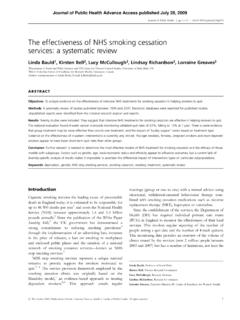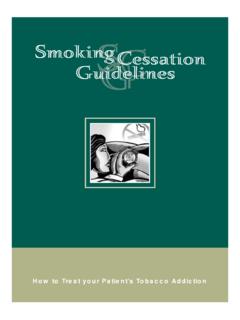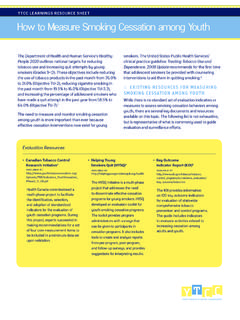Transcription of e-cigarettes briefing [ 2 ] v4 - NCSCT
1 Electronic cigarettes : A briefing for stop smoking services Electronic cigarettes : A briefing for stop smoking services Authors: Andy McEwen and Hayden McRobbie Reviewers: Jamie Brown, Lynne Dawkins, Peter Hajek, Wayne Hall, Elspeth Henderson, Sarah Jakes, Lorien Jollye, Joanne Locker, Louise Ross, Robert West This document has been produced in partnership with Public Health England 2016 National Centre for smoking Cessation and Training ( NCSCT ). Version 2. Date of last modification: January 2016. ISBN 978-0-9565243-4-8. Electronic cigarettes : A briefing for stop smoking services 03. Contents Introduction 04. Background 05. E- cigarettes and stop smoking services 07. Recommendations for practice 13.
2 Regulation 15. Summary of evidence on e- cigarettes 17. Prevalence and epidemiology 19. Why are people using e- cigarettes ? 22. Why do so few people who try e- cigarettes go on to use them regularly? 23. What products are people using? 23. E-cigarette liquid and vapour 24. Quality control 26. Nicotine delivery 27. Do e- cigarettes alleviate withdrawal symptoms? 29. Do e- cigarettes help people reduce or quit smoking ? 29. Are there any adverse health effects of e- cigarettes ? 33. Are e- cigarettes re-normalising smoking ? 37. Conclusion 38. References 39. 04 Electronic cigarettes : A briefing for stop smoking services Introduction This briefing has been written to assist stop smoking services support people who want to use electronic cigarettes (e- cigarettes ) to help them quit smoking .
3 Such an approach brings together the most effective method of quitting (stop smoking services) with the most popular (e- cigarettes ). In August 2015 Public Health England published a comprehensive review of the latest evidence on e-cigarettes1 and an accompanying document highlighting the implications of this evidence for policy and This briefing draws upon these documents to summarise what is currently known about nicotine delivery and the safety of e- cigarettes , and covers some of the issues that have been raised about the use of these devices. We begin by acknowledging that e- cigarettes are considerably safer than smoking cigarettes , are popular with smokers and that they have a role to play in reducing smoking rates.
4 This briefing does not focus on the use of e- cigarettes in the general population for managing temporary abstinence, nor as part of an attempt to reduce the amount of cigarettes being smoked. While the evidence base on e- cigarettes is growing, there are a limited number of good quality and reliable studies, especially on the subject of cessation which is the main driver for public health interventions. In addition, this briefing is limited by the fact that the e-cigarette market is continuing to develop and that there is no single e-cigarette model. Many different forms exist, each with their own technology, delivery and nicotine concentrations;. people also differ in how they use these devices.
5 This briefing makes recommendations for stop smoking practitioners and services, provides common questions and suggested answers about e- cigarettes , and summarises the evidence upon which these recommendations are drawn. Electronic cigarettes : A briefing for stop smoking services 05. Background E- cigarettes are devices that deliver nicotine within an inhalable aerosol by heating a solution that typically contains nicotine, propylene glycol and/or glycerol, plus flavours. This aerosol is commonly referred to as vapour and so the use of an e-cigarette is described as vaping. Unlike cigarettes , there is no combustion (burning) involved in e- cigarettes so there is no smoke and no other harmful products of combustion, such as tar and carbon monoxide.
6 The development of the first e-cigarette is generally attributed to Hon Lik at the Chinese company Ruyan in E- cigarettes appeared in the UK a few years later and the number of people reporting using them was such that they began appearing in national surveys from 2011. It is currently estimated that there are million e-cigarette users in Britain. E- cigarettes generally consist of a battery, a heating element or coil (atomiser). and e-cigarette liquid (e-liquid). The e-liquid can be in sealed cartridges or added to a tank system. Some e- cigarettes use cartomisers that combine the atomiser and e-liquid in a single unit. Although some cartomisers are refillable, most are disposable and designed for single use.
7 Is nicotine dangerous? Nicotine does not cause smoking related disease, such as cancers and heart disease. These are caused by other chemicals found in tobacco smoke. Nicotine is addictive however and it is why people continue to smoke despite knowing about the harmful effects of tobacco. Nicotine in e- cigarettes poses little danger to adult users. In order to prevent accidental poisoning of children, e- cigarettes and liquids should be stored away safely (just as you would with household cleaning products and medicines, including NRT products). 06 Electronic cigarettes : A briefing for stop smoking services First generation e- cigarettes , sometimes called cigalikes, are designed to look like a cigarette and generally use cartomisers.
8 When the user takes a puff (or presses a button on some models) a heating coil is activated to vapourise the e-liquid, creating a vapour that can be inhaled. Many first generation models have a light on the end of the device that also glows when a puff is taken. More experienced e-cigarette users (vapers) prefer to use newer (second and third). generation e- cigarettes . Often called personal vaporisers, these are particularly popular with people who have completely replaced their cigarette smoking with e-cigarette use. Second generation e- cigarettes are typically larger and have a more powerful battery linked to an atomiser and a tank'. The user fills the tank with their choice of e-liquid which may include flavours and contain nicotine in different concentrations.
9 These devices often look like a fountain pen and can be used with a range of atomisers, cartomisers and tank systems. They typically use larger batteries and may have adjustable power settings. Third generation e- cigarettes are usually larger still with a more powerful battery and adjustable air flow. They also allow the user to adjust the voltage or wattage applied to the atomiser (often referred to as variable voltage' or variable wattage'. devices). Some come with puff counters' or downloadable software that allow users to program their own voltage and wattage level, and to monitor their patterns of use. Third generation devices are designed to allow modifications and substitution of individual components according to user preference.
10 Every time I see someone vaping I think: that's another person NOT smoking a cigarette.. Louise Ross, Leicester City Stop smoking Service Electronic cigarettes : A briefing for stop smoking services 07. Figure 1: The three generations of e- cigarettes First generation Second generation Third generation Images courtesy of Anna Phillips E- cigarettes and stop smoking services Public Health England recommends that stop smoking services should offer support to people who are using e- cigarettes in a quit ,4 Clients using unlicensed nicotine containing products (NCP, usually e- cigarettes ) can be included in the national data returns that stop smoking services submit.*. Data from English stop smoking services for the year 2014 15 show that 2,221.


















